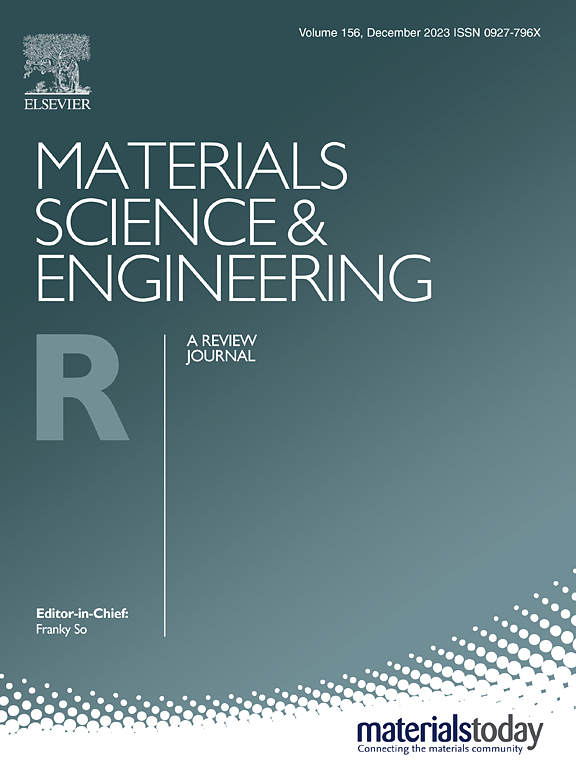探索羟基磷灰石基材料在生物医学中的潜力:全面综述
IF 31.6
1区 材料科学
Q1 MATERIALS SCIENCE, MULTIDISCIPLINARY
引用次数: 0
摘要
羟基磷灰石(HA)在化学成分和结构上都与磷酸骨系统相似,由于其出色的生物相容性、生物活性、骨传导性和骨诱导性,在生物医学领域备受关注。HA 与骨组织中的矿物质相类似,因此在骨移植和植入、牙科材料和给药系统中得到广泛应用。此外,HA 的特性可通过各种合成方法进行定制,包括沉淀法、溶胶-凝胶法和生物仿生法,从而生产出具有精确控制特性的定制材料。近期的研究重点是通过与聚合物、陶瓷和其他成分的复合配方来增强 HA 的机械强度、生物可降解性和生物活性,从而开发出性能更好的先进生物材料,用于各种生物医学应用。本综述概述了 HA 及其衍生物的各种制造方法,重点介绍了它们的生物医学应用和最新进展。关于 HA 的合成和功能化,重点关注创新和高效的方法、晶体结构和形态的精确控制、表面和掺杂改性以及仿生学。重点是将 HA 与其他生物材料相结合,用于组织再生、植入物、癌症治疗和诊断。优化 HA 的机械性能和生物相容性、根据个体差异进行个性化定制以及增强抗菌性能对于组织再生和植入物至关重要。在抗肿瘤方面,需要进一步探索精确疗法和综合疗法,以及 HA 与肿瘤细胞之间相互作用的分子机制。此外,还讨论了在牙髓病学和抗炎治疗中的新用途。综述最后提出了未来的研究方向,以有效应对更广泛的医学挑战。本文章由计算机程序翻译,如有差异,请以英文原文为准。
Exploring the potential of hydroxyapatite-based materials in biomedicine: A comprehensive review
Hydroxyapatite (HA), which shares similarities in both chemical composition and structure with bone phosphate systems, and has garnered significant attention in biomedicine due to its outstanding biocompatibility, bioactivity, osteoconduction, and osteoinductivity. Its resemblance to the mineral phase found in bone tissue has led to its extensive utilization in bone grafting and implantation, dental materials, and drug delivery systems. Furthermore, HA’s characteristics can be tailored on various synthetic methods, including precipitation, sol-gel, and biomimetic approaches allowing for the production of customized materials with precisely controlled properties. Recent research has focused on enhancing the HA’s mechanical strength, biodegradability, and bioactivity through composite formulations with polymers, ceramics, and other components, aiming to develop advanced biomaterials with improved properties for myriad biomedical applications. This comprehensive review outlines the diverse fabrication methods for HA and its derivatives, highlighting their biomedical applications and recent advancements. As for the synthesis and functionalization of HA, attentions have been paid to the innovative and efficient methods, precise control of crystal structure and morphology, surface and doping modification, and bionics. Special focus is placed on combining HA with other biomaterials for tissue regeneration, implants, cancer therapy and diagnostics. Optimization of mechanical properties and biocompatibility of HA, personalized customization according to individual differences, and enhancement of antibacterial properties are essential for tissue regeneration and implants. For anti-tumor, precise and combination therapies, as well as the molecular mechanism of the interaction between HA and tumor cells, need to be further explored. Emerging uses in endodontics and anti-inflammatory treatments are also discussed. The review concludes by proposing future research directions to address a wider range of medical challenges effectively.
求助全文
通过发布文献求助,成功后即可免费获取论文全文。
去求助
来源期刊

Materials Science and Engineering: R: Reports
工程技术-材料科学:综合
CiteScore
60.50
自引率
0.30%
发文量
19
审稿时长
34 days
期刊介绍:
Materials Science & Engineering R: Reports is a journal that covers a wide range of topics in the field of materials science and engineering. It publishes both experimental and theoretical research papers, providing background information and critical assessments on various topics. The journal aims to publish high-quality and novel research papers and reviews.
The subject areas covered by the journal include Materials Science (General), Electronic Materials, Optical Materials, and Magnetic Materials. In addition to regular issues, the journal also publishes special issues on key themes in the field of materials science, including Energy Materials, Materials for Health, Materials Discovery, Innovation for High Value Manufacturing, and Sustainable Materials development.
 求助内容:
求助内容: 应助结果提醒方式:
应助结果提醒方式:


